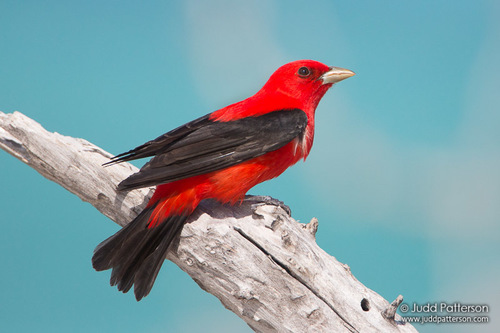
Scarlet Tanager
The Scarlet Tanager (Piranga olivacea) is a striking, medium-sized songbird renowned for the brilliant red plumage of the breeding male. This Neotropical migrant plays a vital role in forest ecosystems as an insectivore, helping to control populations of forest pests. While not widely known for cultural significance, its beauty has made it a favorite among birdwatchers, and its presence is often considered an indicator of healthy, mature forest habitats.
16-19 cm
Length
25-30 cm
Wingspan
Least Concern
Conservation Status
Distribution
Breeds across eastern North America, from southeastern Canada to the southeastern United States. Winters in northwestern South America, primarily in Colombia, Ecuador, Peru, and Bolivia. Migrates through Central America and the Caribbean.
Lifespan
Up to 10 years in the wild (based on banding records).
Scarlet Tanager's Habitat
Habitat Types
Mature deciduous forests, Mixed deciduous-coniferous forests, Forest edges
Climate Zones
Temperate (breeding), Tropical (wintering)
Adaptations
Prefers forests with a closed canopy and a well-developed understory. Their preference for interior forest habitats makes them sensitive to habitat fragmentation.
Variations
No recognized subspecies.
Appearance
Breeding Plumage
Breeding males are bright red with black wings and tail. Females and non-breeding males are olive-yellow above and yellowish below, with darker wings.
Seasonal Feather Changes
Males molt into a non-breeding plumage similar to the female's after breeding season.
Sex Based Plumage Differences
Strong sexual dimorphism during breeding season; males are brightly colored, females are more cryptic.
Notable Features
Black wings and tail in breeding males contrast sharply with red body., Relatively thick, pointed bill.
Diet and Feeding
Primary Foods
Insects, Spiders, Fruits (especially during migration and winter)
Foraging Behavior
Primarily gleans insects from leaves and branches in the forest canopy. Also hovers to catch insects in mid-air and occasionally forages on the ground.
Specializations
Their varied foraging techniques allow them to exploit a wide range of insect prey.
Seasonal Diet Variations
Diet shifts to include more fruits during migration and in wintering grounds when insects are less abundant.
Behavior
Social Structure
Generally solitary or in pairs during the breeding season. May form small flocks during migration.
Communication
Song is a series of hoarse, burry phrases, often described as sounding like a robin with a sore throat., Call note is a distinctive 'chip-burr'.
Migration
Long-distance migrant. Travels at night, often in mixed-species flocks. Uses a combination of celestial cues, magnetic fields, and landmarks for navigation.
Territorial or Group Behaviors
Males are territorial during the breeding season, defending their nesting area from other males.
Conservation
Threats
Habitat loss and fragmentation (both breeding and wintering grounds), Collisions with buildings and other structures during migration, Pesticide use (reducing insect prey availability)
Protection Programs
Conservation of mature forests, Efforts to reduce bird collisions (e.g., bird-friendly building designs)
Local National Laws
Protected under the Migratory Bird Treaty Act in the United States and Canada.
Population Trend
Stable
Population Estimates
Approximately 6.3 million individuals (Partners in Flight estimate).
Interesting Facts
Scarlet Tanagers are known for their 'chip-burr' call.
This distinctive call helps birdwatchers locate them even when they are hidden in the dense foliage.
They undergo a complete molt twice a year.
This is unusual for songbirds, most of which have only one complete molt per year.
Males lose their bright red color after the breeding season.
They molt into a duller, olive-green plumage similar to the female, providing better camouflage during migration and winter.
Faqs about Scarlet Tanager
Where can I see a Scarlet Tanager?
Look for them in mature deciduous forests in eastern North America during the breeding season (May-July). They are often high in the canopy, so binoculars are helpful.
What do Scarlet Tanagers eat?
They primarily eat insects, but also consume fruits, especially during migration and winter.
Why are male Scarlet Tanagers so brightly colored?
The bright red plumage of the male is used to attract females during the breeding season.
Are Scarlet Tanager endangered?
No. Scarlet Tanagers are categorized by the IUCN as 'Least Concern'. However, habitat loss, especially of mature deciduous forest, is a continuing threat.
Copyright @ Nature Style Limited. All Rights Reserved.
 English
English